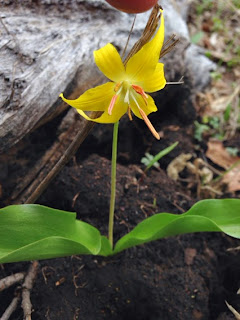 |
| Erythronium grandiflorum |
Samuel Thayer, in his book, Forager's Harvest, speaks very highly of the eastern species, Erythronium americanum or Trout Lily, and mentions that our western Glacier Lily is also good and has a larger bulb. I thought the bulbs were still quite small, and they are several inches deep and rather difficult to dig up. After digging up several specimens, both before and during flowering, I found that the bulbs were sweetest while the flower was in bloom, which is good news for finding them at the right stage at least. They are crisp and quite sweet in bloom, but the difficulty of digging them up discourages me from wanting to seek them out.
The leaves, however, are quite easy to pick and are a very good raw salad leaf. They have a succulent flavor, and are certainly worth the effort of picking. Because these lilies only grow two leaves, picking them is going to be almost as traumatic to the plant as digging it up entirely, so be sure to harvest from an area where they grow so abundantly that your guilt is not tripped.
Below is a picture of several roots I dug up. The outer brown coating is easy to rub off, leaving the edible white root fairly clean. The white part of the stem gives an indication of how deep each one was. The stem, like the leaves and root, is edible, and gets sweeter the closer you get to the root.
After the flower fades, it produces a seed pod, which you can learn to recognize after some experience with the plant. This is also edible. It is fairly crunchy and good tasting, comparible with garden peas.
Eating several of the whole plants or seed pods will eventually produce a slight burny sensation is the back of the throat. Some people can detect it sooner but it takes more than three for me. I have not yet tried cooking them to see if that reduces it, but the demulcence of a violet leaf helps to remove that feeling.

No comments:
Post a Comment